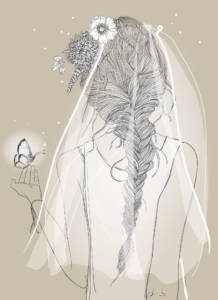
Wedding veils can add an aura of grandeur to your wedding attire, and may enhance your wardrobe depending on your beliefs and tastes.
In 2015, Wedding Bells estimated that around 160,000 weddings are performed annually in Canada. For many brides, assembling their attire for the special day is a mix of major decisions and minor details. That includes whether to include wedding veils, garments once taken for granted as automatic parts of a bride’s nuptial attire. Whether you wear this iconic piece of nuptial apparel or not is your choice. As you deliberate, it’s helpful to know some of the histories behind the practice of wearing wedding veils, plus the style and fabric options at your disposal.
Why Have Brides Worn Veils?
In Western weddings, veils have been a ubiquitous staple in bridal wear. While there are many possible origins of this custom, most writers suggest that they were worn either for superstitious, practical, religious or surreptitious reasons. Some say brides donned them in ancient Rome to keep evil spirits at bay, while others believe the practice may have been adopted to prevent grooms from seeing their future spouses until the last possible minute. Meanwhile, others point to the symbolism of purity and virginity, both in religious and social contexts, along with potentially troubling implications that they may be a relic from patriarchal times when women were seen as property. It’s also been suggested that brides may have worn them to keep angry, rival lovers from spotting and abducting them from their own ceremonies!
The Pros and Cons of Wedding Veils
If your special day is veil-optional, you might have several reasons to pick them—and probably just as many to ditch them. On one hand, your wedding is probably the only time you’ll get to wear such a delicate, gorgeous accessory. Your entrance into the venue while draped in its fabric, as well as the moment when it’s lifted from your face, can provide stunning points of drama in your ceremony. Moreover, most versions are detachable and are friendly on your budget. Conversely, you may find the traditional meanings behind them distasteful or contrary to your beliefs on gender equality. On a more practical note, they can be unwieldy, easily tossed about by the wind or becoming a prime attraction for insects of the flying, stinging kind.
An Endless Array of Styles and Options
Understanding the kinds of wedding veils available on the market can aid in choosing the best one for your wedding day ensemble. The Knot provides a great guide on some common lengths and cuts. Shorter versions include the birdcage, a unique option that pairs well with vintage gowns, and the blusher, a single-layer veil with a hemline that ends just short of the tip of your nose. Longer varieties include flyaway, elbow and fingertip veils. Cathedral and chapel lengths are usually the longest versions, adding an extra dose of grandeur to formal wedding gowns.
Fabric also contributes to a veil’s look and feel. The VeilStyle Blog published a thorough resource on typical options such as tulle, nylon, chiffon and organza. One kind of nylon material known as “Bridal Illusion” is translucent, making it ideal for photographs. Some varieties, such as silk tulle, drape well but are more fragile. Silk chiffon, a natural fiber, is best for single-layer designs due to its heavier weight. Finally, organza is crisp, with a fine texture and a beautiful sheen.
Religious Significance or Wedding Day Drama
Wedding veils can sometimes evoke some “spirited” debate over how, when and by whom they should be worn. If you opt to incorporate one in your ensemble, you have a huge range of cuts, materials and colors from which to select. Personal preference, religious beliefs and sartorial sensibilities may dictate whether you don one or not on your special day.


